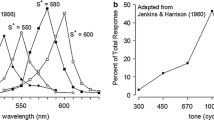Abstract
Subjects in conditioning experiments time their conditioned responses relative to the onsets of the conditioned stimuli (CSs). These onsets are temporal landmarks, by reference to which subjects may estimate the location of the unconditioned stimulus (US) in time. In a serial compound conditioning paradigm, a long duration CS comes on first, followed later by a second shorter CS, creating both a long-range and a short-range predictor of the US. We ask whether displacing the short-range predictor relative to the long-range predictor causes subjects to strike a compromise between the different temporal locations predicted by the two CSs. In three experiments with pigeons, we varied the training conditions so as to favor or militate against this outcome. However, in all conditions, there was no compromise; after the onset of the displaced short-range CS, the timing of conditioned responding was governed by it alone. This result contrasts with the compromises that are seen when the feeding time predicted by a CS is put in conflict with the time predicted by the circadian clock, and with the similar compromises sometimes seen when a nearby spatial landmark is displaced relative to a larger spatial context.



Similar content being viewed by others
References
Cheng K (1989) The vector sum model of pigeon landmark use. J Exp Psychol: Anim Behav Process15:366–375
Collett M, Harland D, Collett TS (2002) The use of landmarks and panoramic context in the performance of local vectors by navigating bees. J Exp Biol 205:807–814
Gallistel CR (1990) The organization of learning. Bradford Books/MIT Press, Cambridge, Mass
Gallistel CR (2002) Frequency, contingency and the information processing theory of conditioning. In: Sedelmeier P, Betsch T (eds) Etc. frequency processing and cognition. Oxford University Press, Oxford pp 153–171
Gallistel CR, Gibbon J (2000) Time, rate and conditioning. Psychol Rev 107:289–344
Gibbon J (1977) Scalar expectancy theory and Weber's Law in animal timing. Psychol Rev 84:279–335
Gibbon J, Fairhurst S, Goldberg B (1997) Cooperation, conflict and compromise between circadian and interval clocks in pigeons. In: Bradshaw ECM, Szabadi EE (eds) Time and behaviour: psychological and neurobehavioural analyses. Elsevier, Amsterdam, pp 329–384
Holland PC (1983) Occasion-setting in Pavlovian feature positive discriminations. In: Commons ML, Herrnstein RJ, Wagner AR (eds) Quantitative analyses of behavior: discrimination processes. Ballinger, New York, pp 183–206
Holland PC (1986) Temporal determinants of occasion setting in feature positive discriminations. Anim Learn Behav 14:11–120
Holland PC, Hamlin PA, Parsons JP (1997) Temporal specificity in serial feature-positive discrimination learning. J Exp Psychol: Anim Behav Process 23:95–109
Honig WK (1981) Working memory and the temporal map. In: Spear NE, Miller RR (eds) Information processing in animals: memory mechanisms. Erlbaum, Hillsdale, NJ, pp 167–197
Killeen PR, Weiss NA (1987) Optimal timing and the Weber function. Psychol Rev 94:455–468
Miller RR, Barnet RC (1993) The role of time in elementary associations. Curr Dir Psychol Sci 2:106–111
Mistlberger RE (1994) Circadian food-anticipatory activity: formal models and physiological mechanisms. Neurosci Biobehav Rev 18:171–195
Savastano HI, Miller RR (1998) Time as content in Pavlovian conditioning. Behav Proc 44:147–162
Shannon CE (1948) A mathematical theory of communication. Bell Syst Tech J, 27:379–423, 623–656
Srinivasan MV, Zhang SW, Bidwell NJ (1997) Visually mediated odometry in honeybees navigation en route to the goal: visual flight control and odometery. J Exp Biol 200: 2513–2522
Acknowledgements
Grant MH14649 from the National Institute of Health (USA) to John Gibbon supported this research. The research was conducted in accord with the prior approval of the Institutional Review Board of the New York State Psychiatric Institute and with all applicable animal care and welfare laws and regulations. The helpful comments and suggestions of Peter Balsam are gratefully acknowledged.
Author information
Authors and Affiliations
Corresponding author
Additional information
John Gibbon died while this work was being prepared for publication
Rights and permissions
About this article
Cite this article
Fairhurst, S., Gallistel, C.R. & Gibbon, J. Temporal landmarks: proximity prevails. Anim Cogn 6, 113–120 (2003). https://doi.org/10.1007/s10071-003-0169-8
Received:
Revised:
Accepted:
Published:
Issue Date:
DOI: https://doi.org/10.1007/s10071-003-0169-8




